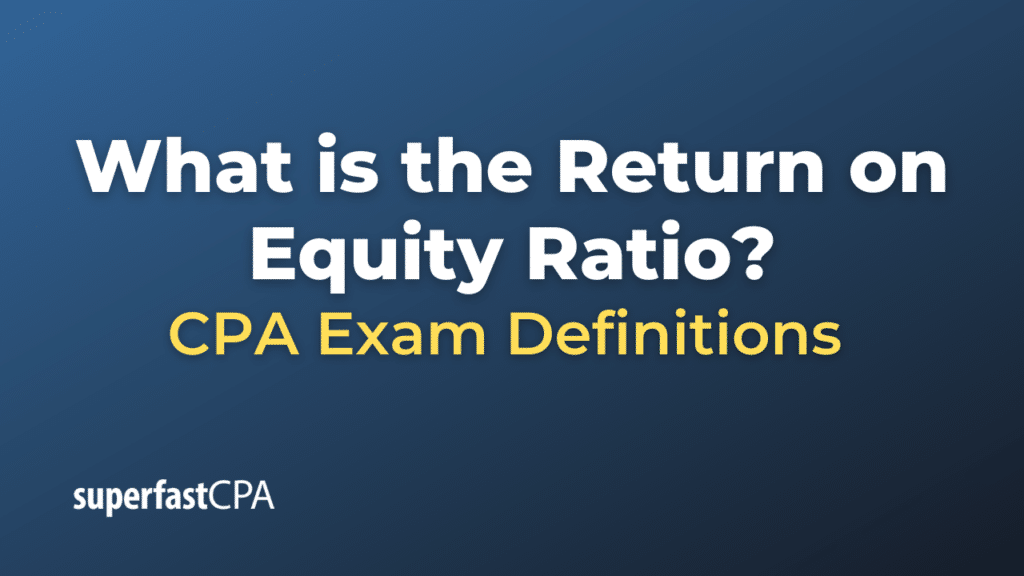Return on Equity Ratio
The Return on Equity (ROE) ratio is a key financial metric used to measure the profitability of a company relative to its equity. It provides insight into how effectively management is using a company’s equity to generate earnings.
The formula for ROE is:
ROE = Net Income / Average Shareholders’ Equity
Where:
- Net Income refers to the profit of the company after all expenses, including taxes, have been deducted.
- Average Shareholders’ Equity is typically calculated as the average of the beginning and ending shareholders’ equity for a given period (e.g., a fiscal year). This represents the net value of the company that shareholders have equity in.
In essence, ROE indicates the amount of net income produced for every dollar of equity. A higher ROE suggests that the company is effectively using its equity to generate profits, making it an attractive metric for potential investors and analysts to gauge a company’s profitability performance.
It’s important to note the following when analyzing the ROE ratio:
- Industry Comparison: ROE should ideally be compared with companies in the same industry to get a relative perspective. Different industries have different levels of capital intensity and financial structures.
- Sustainability: A consistently high ROE over a period suggests sustainable performance. However, one should ensure that the ROE is not artificially inflated due to high financial leverage (debt).
- Financial Leverage Impact : Companies with significant debt can have higher ROE due to the leveraging effect. However, this can also increase financial risk. This is why many analysts use the DuPont analysis, as previously explained, to break down ROE and understand its drivers.
- Changes Over Time : Tracking the changes in ROE over multiple periods can provide insights into the trend of a company’s profitability and equity efficiency.
In summary, the ROE ratio is a fundamental measure of how well a company uses the money shareholders have invested to generate profits. It is a widely used metric in financial analysis and investment decision-making.
Example of the Return on Equity Ratio
Let’s illustrate the Return on Equity (ROE) ratio with a fictional company, DEF Ltd.
Company DEF Ltd Financials for the Year:
- Net Income: $300,000
- Shareholders’ Equity at the Beginning of the Year: $1,200,000
- Shareholders’ Equity at the End of the Year: $1,500,000
Steps to calculate ROE:
- Calculate Average Shareholders’ Equity:
Average Shareholders’ Equity = Shareholders’ Equity at the Beginning of the Year + Shareholders’ Equity at the End of the Year / 2
Average Shareholders’ Equity = 1,200,000 + 1,500,000 / 2
Average Shareholders’ Equity = 1,350,000
- Calculate ROE:
ROE=Net Income / Average Shareholders’ Equity
ROE = 300,000 / 1,350,000
ROE = 0.2222
When expressed as a percentage, DEF Ltd’s ROE is 22.22%.
Analysis:
This result means that for every dollar of equity invested in DEF Ltd, the company generated a profit of $0.2222 (or 22.22 cents) during the year.
In real-world applications, to make this figure meaningful, an investor or analyst would typically:
- Compare this ROE figure to DEF Ltd’s historical ROEs to see if the company’s profitability from equity is improving or deteriorating.
- Benchmark this ROE against other companies in the same industry to see how DEF Ltd stands in terms of profitability.
- Consider external factors and qualitative information to see if there are particular reasons for an especially high or low ROE.
By itself, the ROE ratio doesn’t give definitive answers, but it provides a starting point for understanding a company’s profitability relative to shareholder equity.













